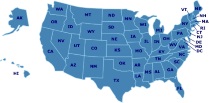Civil Rights Movement
Things to See & Do in Florida
The Ritz Theatre and Museum
Our permanent museum collection presents the history of Northeast Florida's African American community, featuring a walk through old LaVilla and a dynamic multi-media display highlighting brothers James Weldon Johnson and John Rosamond Johnson, Jacksonville native sons and composers of "Lift Ev'ry Voice and Sing." The Museum Gallery showcases a variety of changing art exhibits throughout the year. Guided tours are led by trained docents who will provide information about the exhibits featured in the museum.
Black Archives at the Union Bank
Completed in 1841 when Florida was still a territory, the Union Bank is the state's oldest surviving bank building. Chartered to help finance local cotton plantations, it ultimately closed because of crop failures, the Second Seminole War, and poor management. After the Civil War, it reopened as the Freedman's Savings and Trust Company for emancipated slaves and later served several other functions. In 1971, the Bank was moved from its original site, and, after restoration, it was opened as a museum in 1984. The Union Bank now serves as an extension of the Florida A&M University Black Archives, Research Center and Museum and is open to the public and school groups only on weekdays. Artifacts and documents reflecting black history and culture are on display, and public programs are provided by Black Archives staff. The museum is located in Tallahassee, Florida.
Fort Mose Historical State Park
The power politics of 18th century England and Spain reached across the Atlantic to the Florida frontier. In 1738, the Spanish governor of Florida chartered Fort Mose as a settlement for freed Africans who had fled slavery in the British Carolinas. When Spain ceded Florida to Britain in 1763, the inhabitants of Fort Mose migrated to Cuba. Although nothing remains of the fort, the site was listed on the National Register of Historic Places in 1994 for its importance in American history. Visitors may view the site from a boardwalk and stop for a picnic in a covered pavilion.
Knott House Museum
Built in 1843, probably by free black builder George Proctor, the Knott House was first occupied by attorney Thomas Hagner and his wife Catherine Gamble. The house served as temporary Union Headquarters in 1865, where Brigadier General Edward McCook announced the Emancipation Proclamation. Physician Dr. George Betton made the location his home and office in the 1880s. Betton assisted in the early medical training of his carriage driver, William Gunn, who became Florida’s first African - American physician. In the early 20th century, three Florida Supreme Court judges lived in the house, acquired by William and Luella Knott in 1928. As the wife of a state treasurer, Luella hosted notable social functions, and as a poet, she wrote verses about the home and its furnishings, causing the site to be known as "The House That Rhymes." With the death of the Knott's son in 1985, the Historic Tallahassee Preservation Board became the beneficiary, and after extensive renovations, the Knott House Museum opened to the public in 1992. Its administration was transferred to the Museum of Florida History in 1997.
John G. Riley Center/Museum of African American History and Culture
The Riley House is a little known historical and cultural gem that sits at the bottom of a hill in downtown Tallahassee, at the corner of Meridian and Jefferson Streets. In 1978, through the efforts of local preservationists, the Riley House became the second house in Florida owned by a black person to be placed on the National Register of Historic Places, the first being the Mary McLeod Bethune house in Volusia County. In 1995, a group of Tallahassee citizens established a museum at the Riley House dedicated to African-American history and culture. This facility draws more visitors and tourist into the area while providing a historically diverse attraction.
Featured Resources
As an Amazon Associate, we earn from qualifying purchases. We get commissions for purchases made through links on this site.
Florida History from the Highways
Discover Florida, with its unique geography and exciting history--from ancient gold to modern real estate speculation--by journeying along its highways. Beginning with a chronology and succinct account of Florida's spectacular development, then an account of the rise of the major cities, Florida History from the Highways takes you throughout the state, pointing out the fascinating events that occurred at locations along the way. You'll travel through changing times and landscapes and emerge fill...
Sing, Spell, Read & Write
Sing, Spell, Read & Write is a phonics-based program that uses a 36-step program of carefully sequenced steps to teach reading, writing, and spelling. More product information can be found here.
Raising Topsy-Turvy Kids: Successfully Parenting Your Visual-Spatial Child
Understanding how children learn best allows you to meet their needs and help them succeed. A visual-spatial learner remembers things in pictures and learns better with visual clues and strategies. This book addresses those needs and helps you figure out how to encourage this type of learner in your homeschool environment.
Responsible Driving, Student Edition
This easy-to-read book features explanations of safe driving techniques and is used in many states as a textbook for in-class driving instruction. It is a great learning tool for a new driver and a good refresher for the more experienced driver.
Homeschooling 101: A Guide to Getting Started
Homeschooling 101 gives you the steps to help you get started on your homeschool journey. This guide lays out how to get started, choose and gather curriculum, scheduling, organizing your home, and finding the joy in homeschooling. This book is perfect for new homeschoolers who are looking for real help in taking the first step.



